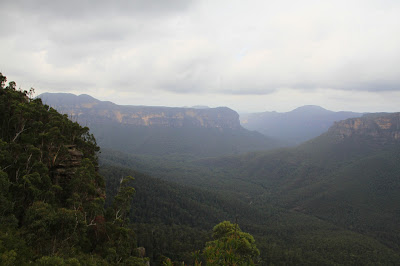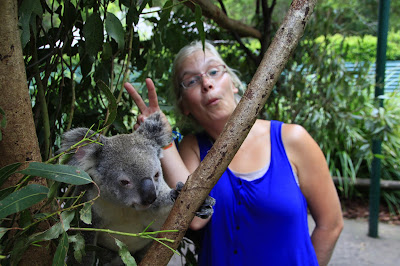The Green

We picked up our new campervan, the 'Rasende Rita', on another steamy afternoon in tropical Cairns and ventured further north into the World Heritage listed Daintree Rainforest National Park. On our way there we spent a beautiful night out at the amazingly pretty Palm Cove, stayed at the most beautiful campground under palmtrees right at the turquoise ocean waters, went shopping in the charming little seaside town of Port Douglas and got excited about our first roadside Wallabies. When we finally got into the Daintree area the thick, lush vegetation amazed us. After the temperate rainforests of NZ this was completely different again and reminded more of Southeast Asian jungles: lots of huge trees, climbers, flowers and tons of animals - some of which were rather disturbing (the stories of how we barely escaped a snake attack and how we hunted down big crocks could be told here...you always have to be on the watch in this wilderness!) - and beautiful rivers, creeks and waterfalls that invited for a swim. We explored the Mossman Gorge before starting our long way south that will eventually take us back to Sydney.

We stayed a night at picturesque Etty Bay where the dark green forest comes down all the way to meet white sand and clear blue ocean. The next morning we had a visitor for breakfast - a beautiful, big Cassowary checked out our meal before deciding to rather keep feeding on his forest fruits. Cassowaries are flightless birds with a bump on their heads that makes them look like straight from Jourrasic Park and they are quite rare so we were lucky to see it just like that. From Etty Bay we ventured inland to see Australia's highest single-drop waterfall, the Waksman Falls. Their thundering sounds announced them from afar and their stunning fall over a wall of sheer cliff was quite amazing. We hiked down from the top viewing platform through more steaming hot rainforest where this time we were attacked by the flora - dangeling thorny vines, stinging trees and the like...The view from the bottom pool of the fall was nice enough though, so we didn't mind the pain too much.
 |
| Cassowary - an encounter next to our van |

After a night under trees that we spent watching the fabulous Tree Kangaroos play and look for food ( and getting eaten by another camper's dog, but that's too sad a story to tell here) we went back to the coast and explored beautiful 'The Strand' of Townsville: a park-like area with white beaches, public pools, lots of shade from Perott-housing trees, cafes, sporting facilities etc. We took a stroll, enjoyed an ice cream and stared at the biggest Iguana either of us has ever seen in our lives. The tropical heat and humidity eventually drove us back into the soothing cool of air conditioned Rita and we went on to the little town of Ayr from where we wanted to go diving again. The wreck of the Yongala lies in the ocean only 30 minutes out from Ayr and it counts as one of the top ten dive sites in the world due to its amazing corals and marine life. Unfortunatelly, when we got to Ayr, the sky and sea had turned dark and stormy so there was no trip out to the wreck in at least the following two days. As we were a little pressed on time all that was left for us to do was to continue on the next day without having seen the Yongala. The weather stayed wet and foggy so we decided not to go for an expensive cruise around the supposedly paradise-like Whitsunday islands to spare us another disappointment. Instead we took the road less travelled and went back inland, into the lush, mountainous rainforest of the Eungella National Park.
 |
| Platypus surfacing while digesting |
After overcoming a number of roadblockages by fallen trees and flooded streets we arrived at our destination, the Broken River, just in time to spot what we came for: Platypuses. There is a small viewing platform that offers views over a rather wide stretch of the river. When we got there, a little Platypus was swimming around the surface. It was much smaller than we had expected a Platypus to be and it was really really funny and absolutely wonderful to watch. It pedalled around with its little fins, munched away on its food that it frequently dived for and played around while just floating on the surface. We spotted three other specimen as well, but that first one stayed our favorites and it came closest (a brave little fella as Platypuses are very shy). If you don't know much about Platypuses definitely go and look them up 'cause they are amazing!
The Red
We were driving across the bushland to the outback and saw some grass. We drove a little further and were excited to see a kangaroo. We then got to see more grass. After many miles of breathtaking kangaroos, we got to see a wondrous bunch of eucalyptus trees. Later that day, we came around this one corner and got to see more kangaroos and they were standing in more grass, and they were surrounded by a lot more eucalyptus trees...Next time we're flying!

On a more serious note, we saw a lot more than just grass, kangaroos and eucalyptus trees. We crossed gigantic coalmines and drove along their equally gigantic coal trains. We shared the road with massive road-trains. We saw beautiful birds and met old, rusty locals in their long forgotten one-man villages. We saw the clearest and brightest stary sky in the darkest of all nights. We saw the devastation a bush fire can bring. And above all, we saw the red, burnt earth that makes up this huge, wide country. So would we really rather fly the next time? Never.
The Blue
During our time in the bush, we came across the legendary Sapphire Fields. The gemfields can not be mined by heavy machinery, so most of the many mines are teeny tiny private ones, run by old miners that have spent their lives out there, hoping to one day get really lucky. Most of them are still waiting for that day to come, but the fields are quite rich so not only do they supply the world with 80 percent of all sapphires but also does every now and then someone get more lucky than usual and walk out with sapphires the size of a brick. We visited an old mine and took a guided tour through the shafts and tunnels. After we had learnt all we needed to know about sapphire mining that way, we tried our luck. We bought a bucket of wash (a bucket full of the part of the earth that might contain gemstones) and got our hands dirty on fosicking. And who would have guessed - in contrast to our hard efforts in gold panning in NZ this time we really got lucky. We found a couple of beautiful, dark blue sapphires, two of which are even quite big. Their colour is amazing - and it reminded us of the ocean, a place we wanted to return to. So we drove back to Rockhampton, where we didn't see the ocean but some evidence of the devastation the recent floods brought to the area. Since Rockhampton is OZ's beef capital, we went for dinner to a real nice steakhouse and were served some excellent meat before we went on to the city of Bundaberg. That's where we really got to see the horrible power of the storm that hit the eastern coast some weeks ago. Half of the city is closed down, houses are emptied out and left to slowly dry, boats ly around tops down in parks after being blown there from the river, tires and waste hang in trees, streets are still flooded, sugarcane fields and fruit plantations are flattened- in short, it's pretty bad. And it's still raining hard...
 |
| Don't drink and drive !! |
We decided to meet the blue mood the city oozes with the only natural answer: a tour of the city's famous 'Bundaberg Rum' distillery, inclusive some fine tasting...that really lifted our spirits. Since we couldn't go on a tour to watch the hatching of baby turtles and their struggle to reach the water due to the flood (the 'Turtle Beach' is closed down for safety reasons...we wonder what happened to the turtle eggs) we went on to the seaside resort of Noosa. With all the heavy rain and stormy weather outside, we stayed inside and looked at postcard images of the paradise that we were (probably) surrounded by instead. It got even worse when we were told that the Koalas that lived in the Noosa National Park (that we had planned on spotting for the next day) recently all died from a disease...well, this stretch of land really seems to have had its fair share of bad luck lately. We went to the National Park despite the empty eucalyptus trees and the pouring rain and went for a coastal hike. The ocean wasn't turquoise and calm like on the pictures but grey and rough, an unforgiving sea. We saw waves as high as houses that formed and crushed far out. And we saw the madness of tons of surfers that tried to catch the baby brothers of the giant waves that were still some meters tall. Through all this end-of-the-world weather we tried to stay positive (opened a couple of souvenir bottles from Bundaberg - the gingerbeer of course...), but we could seriously do with some good weather now that at least lets us experience some of the coastal highlights that eastern Australia has to offer.





























